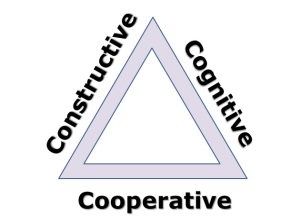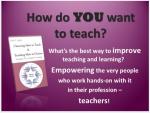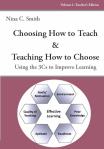Student-centered and emotionally safe pedagogy is a choice, an instructional approach in any level of education. It is not a handbook of tips and tricks, to add diversity and equity into instruction, or help us survive our challenging days in the education profession. It is being intellectually and emotionally present when a student needs us. It is also about choosing the instructional strategies to support every students’ individual learning process and learner agency[1].
I have been on the path of critical pedagogy for a long time. During my own K-12 education, I never imagined I would become a teacher, but as an adult I was intrigued by the ways we construct our understanding. Even before I became a teacher I wondered how individual learning could be better supported – because one size does not fit all. It seemed to me that an intellectually and emotionally safe learning environment was very necessary for supporting the learning process. After that realization there was no turning back – I had to study education science. 🙂
Learning happens in a social context, in interactions, and as educators we can make this experience better for our students. Emotionally safe classrooms are flexible by nature and they have rules that are consistent and justified, and preferably created in cooperation with students. Treating students as unique human beings is essential – which makes is hard or impossible to use behaviorist learning theories, or have strong external regulation for learning process. Later I realized that this also describes the DEI – approach for diversity, equity and inclusion. We want to support students’ self-determination because it increases their intrinsic motivation and ownership of their learning process [2].
Learning to learn is a lifelong process. It starts in early childhood, which is why preschool can have such a huge effect in future learning. Good quality early childhood pedagogy focuses on supporting holistic child development and making learning a joyful experience children want to repeat. It is important to also teach children how to help themselves to learn. We do this by increasing their metacognition and guiding children to use a variety of deep learning strategies – based on the learning task they are facing [3]. Learning to write one’s own name requires different strategies than learning to ride a bike. In order to choose, we must be aware about choices we have. And as adults we are still discovering new learning strategies for ourselves – if we keep looking for them. It really IS a life-long process.
We all have our subjective experiences and preferences that inform our choices. Sometimes we need to learn to manage ourselves in a different way – fortunately there are plenty of great SEL resources to use. Please check the CASEL framework and resources! I became familiar with social-emotional learning when I was earning my M.Ed. in Finland, and it has been a crucially important part of the learner-centered and emotionally safe pedagogy I have been building in my career and discussing in this blog. Stress-free atmosphere helps to build an emotionally safe growing and learning environment. Knowing that their thoughts and ideas are valued helps students think and express their thoughts more freely. More thinking equals more learning.
The one situation when most of us feel threatened or unsafe is while we are receiving feedback. In an emotionally safe classroom feedback becomes a natural part of the learning process, and thus stops being scary – Growth Mindset can be used in this, if we remember to use the pedagogy of kindness and invest in personhood [4]. Focusing on supporting each individual student on their own learning path does take more time than applying standardized measures. But, it is also more effective. Students’ daily self-evaluation and teacher’s verbal comments can create an awesome tool for students to reflect and control their own learning, but it takes time to have those individual interactions with all students. I would like to see classroom sizes small enough to allow more dialogue, because learning still happens in interactions, regardless of the technology we may be using.
It is important to remember that being kind is different from being nice. While being kind I engage in the important (but hard) dialogue about learning, helping my students to understand their own learning process and how they can either help or hinder their own learning. If I were to be just nice, I could say “Good job!” and move on – but that would not help my students to learn more.
References:
[1] Smith, N.C. (2017). Students’ perceptions of learner agency: A phenomenographic inquiry into the lived learning experiences of high school students. (Doctoral Dissertation). Northeastern Repository
[2] Deci, E. L., & Ryan, R. M. (2000). The” what” and” why” of goal pursuits: Human needs and the self-determination of behavior. Psychological inquiry, 11(4), 227-268.
[3] Seif, E. (2018, November 16 )Dimensions Of Deep Learning: Levels Of Engagement And Learning. Association for Supervision and Curriculum Development. https://inservice.ascd.org/dimensions-of-deep-learning-levels-of-engagement-and-learning/
[4] Denial, C. (2020) A pedagogy of kindness. In. L. Stommel, C. Friend, & S.M. Morris (Eds.), Critical digital pedagogy: A collection. Hybrid Pedagogy Incorporated (pp. 212-218). https://hybridpedagogy.org/critical-digital-pedagogy/









